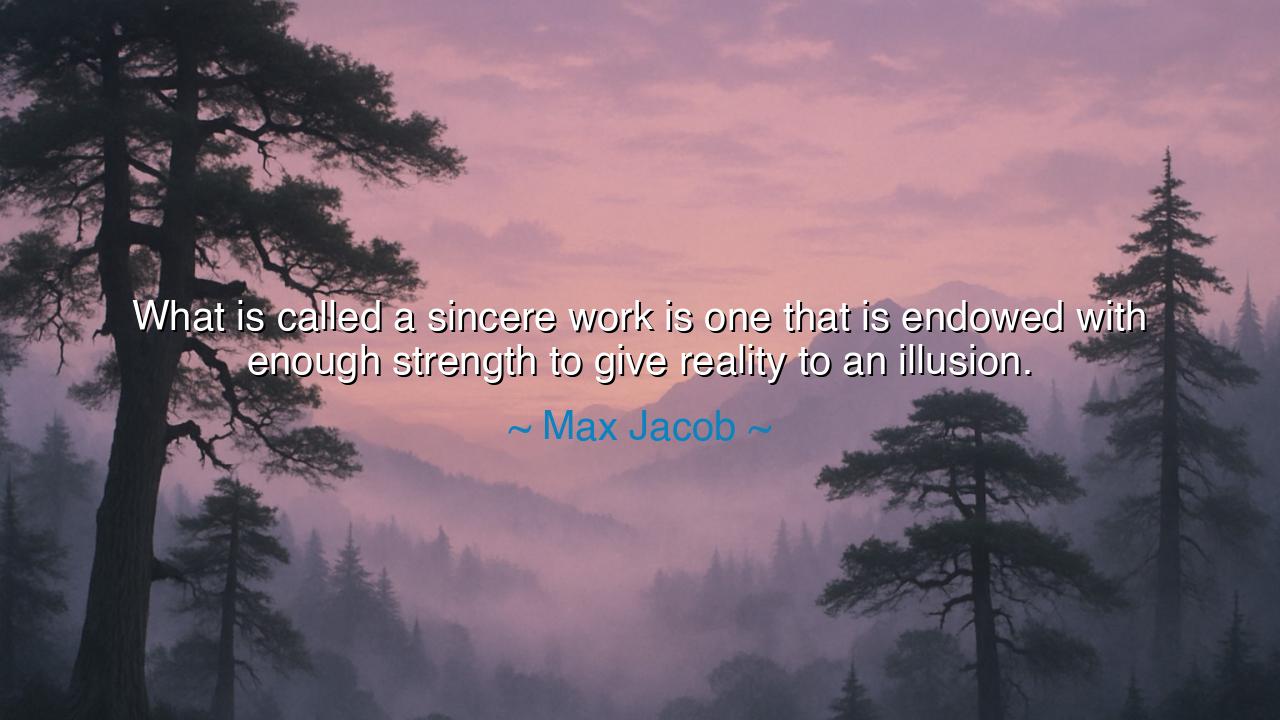
What is called a sincere work is one that is endowed with enough
What is called a sincere work is one that is endowed with enough strength to give reality to an illusion.






Max Jacob’s words, “What is called a sincere work is one that is endowed with enough strength to give reality to an illusion,” pierce into the very essence of art and creation. He reminds us that the highest works of human spirit—be they in poetry, painting, or music—stand not merely as adornments or amusements, but as living entities that transform dream into substance. A sincere work is not shallow pretense, but something so strong in vision, form, and feeling that it convinces the heart of the reality of what, in truth, is imagined.
The origin of this insight lies in Jacob’s life as a poet and painter among the avant-garde circles of early twentieth-century Paris. He moved among visionaries like Picasso and Apollinaire, men who took what seemed impossible or illusory and gave it permanence through their sincere works. Jacob knew from experience that art only endures when it breathes life into what was once ephemeral, when the imagined becomes so real in its expression that it shapes thought, emotion, and even culture.
Consider the example of Shakespeare, whose plays often contained ghosts, witches, and dreamlike visions. These are illusions, yet because they were endowed with the strength of his language, structure, and emotional truth, they became real to generations of audiences. The ghost of Hamlet’s father or the witches of Macbeth are not figments dismissed as fancy—they are living presences in the minds of all who have encountered them. This is the mark of a sincere work: to endow illusion with such strength that it transcends mere invention and touches reality.
History also offers us the case of Leonardo da Vinci, who imagined flying machines long before the age of aviation. On paper, they were illusions, sketches of dreams. Yet the strength of his sincere pursuit of truth in nature made those images more than fantasy. They became seeds that future generations watered, leading eventually to the birth of real flight. Leonardo’s sincere works were infused with enough depth and conviction to give reality to what, in his age, was impossible.
Jacob’s teaching is also a warning against hollow creation. Works made only for vanity, or to mimic fashion, lack the strength to endure. They remain brittle illusions that dissolve with time. But works created from sincerity—rooted in conviction, sacrifice, and authentic vision—are charged with power. They cross the boundary between dream and truth, illusion and reality, leaving an imprint on the world that cannot be erased.
For us who listen, the lesson is clear: when you create—whether art, labor, or even relationships—do so with sincerity. Do not chase appearance, but invest your strength into giving life to what your heart envisions. Your illusion, your dream, can become real if it is carried with the weight of truth, discipline, and passion.
The path forward is this: nurture your vision, but anchor it with strength. Commit your effort to it fully, and let sincerity be your guide. In this way, what once was only a shadow in your imagination can take form and stand in the light of day, living not only for you, but for generations yet unborn.
Thus let Max Jacob’s wisdom endure: a sincere work is the bridge between the unreal and the real, the imagined and the lived. To endow illusion with strength is to act as co-creator with the divine, shaping reality itself. Create with sincerity, and your work will not merely exist—it will live.






AAdministratorAdministrator
Welcome, honored guests. Please leave a comment, we will respond soon